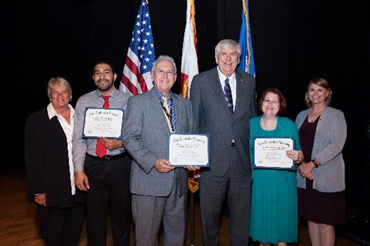Can DNA Repair Capacity in Breast Cancer Stem Cells Predict Recurrence?
Grant Winners
- Jean J. Latimer – College of Pharmacy
- Stephen G. Grant, Ph. D. – College of Medical Sciences
- Omar Ibrahim, B.S. – College of Pharmacy
- Meghna Mendu – Halmos College of Oceanography and Natural Sciences
Deans
- Lisa Deziel, Ph.D., Pham.D, BCPS, FASHP – College of Pharmacy
- Elaine M. Wallace, D.O., M.S., M.S., M.S. – College of Medical Sciences
Abstract

Cancer stem cells are a subset of tumor cells that are believed to be the origin of metastasis. They are considered by many to be the newest target in the development of drugs for cancer. If we imagine the tumor as an organ, the cancer stem cells are, the embodiment of the tumor's ability to fight back when we try to clinically eradicate that tumor. Most of what we know about cancer stem cells is based on studies of human tumor cells during treatment, in immuno-compromised mice. Because of the sheer number of breast cancer cell lines, we have created, our laboratory is in a unique position to study human cancer stem cells in their therapy naive virgin state, and correlate their proportion with patient survival. There is also evidence that cancer stem cells have a superior ability to repair DNA damage compared with the rest of the tumor. These studies have not been done in laboratories specializing in DNA repair. As DNA repair experts, we will be able to test this controversial finding directly, with cancer stem cells from our virgin (pre-treatment) cell lines and also link this determination to patient survival. Our hypothesis in the present proposal is that cancer stem cells in the virgin tumor, reflect the prognosis of the patient based on their number and/or their ability to perform DNA repair. If this is the case, it may be possible to predict whether the tumor cells can also convert to a treatment resistant stem cell population, reflecting what we see in the stem cells of the virgin tumor. Cancer stem cells will be isolated from 5 breast cancer cell lines (using 3 well characterized stem cell markers), that have recurred in 4 years, and 5 that have not recurred. Flow cytometric methods will be used for this isolation and stem cells will be quantified, briefly cultured and subjected to the functional DNA repair (UDS) assay. The assay results will be quantified by published methods (grain counting with integrated assessment of positive and negative controls) and the student's test will be used to determine significance. Breast cancers of similar type will be chosen. Stem cell identity will be confirmed in xenograft mice in a future study once this preliminary work has been performed, but cell lines with stem cells already grown in xenograft mice, will be used to begin.
This study will fill several voids in the field of cancer stem cells: 1. it will establish that breast cancer stem cells can be found in early stage disease, 2. it will assess their ability to correlate with the ultimate patient outcome, 3. it will determine unequivocally and mechanistically whether breast cancer stem cells have a superior ability to repair the DNA damage of bulky adduct producing chemotherapy treatments compared with the non-cancer stem cells of the tumor. If DNA repair does correlate with outcome, then clinically we need to find ways to reduce DNA repair before applying the genotoxic chemotherapy (for example using microRNAs). This work will be done in vitro but can be extended to in vivo studies with future federal funding.